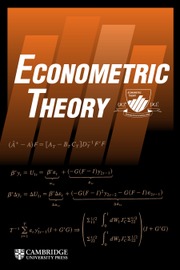No CrossRef data available.
Article contents
REGRESSION DISCONTINUITY DESIGN WITH POTENTIALLY MANY COVARIATES
Published online by Cambridge University Press: 14 February 2025
Abstract
This article examines high-dimensional covariates in regression discontinuity design (RDD) analysis. We introduce estimation and inference methods for the RDD models that incorporate covariate selection while maintaining stability across various numbers of covariates. The proposed methods combine a localization approach using kernel weights with  $\ell _{1}$-penalization to handle high-dimensional covariates. We provide both theoretical and numerical evidence demonstrating the efficacy of our methods. Theoretically, we present risk and coverage properties for our point estimation and inference methods. Conditions are given under which the proposed estimator becomes more efficient than the conventional covariate adjusted estimator at the cost of an additional sparsity condition. Numerically, our simulation experiments and empirical examples show the robust behaviors of the proposed methods to the number of covariates in terms of bias and variance for point estimation and coverage probability and interval length for inference.
$\ell _{1}$-penalization to handle high-dimensional covariates. We provide both theoretical and numerical evidence demonstrating the efficacy of our methods. Theoretically, we present risk and coverage properties for our point estimation and inference methods. Conditions are given under which the proposed estimator becomes more efficient than the conventional covariate adjusted estimator at the cost of an additional sparsity condition. Numerically, our simulation experiments and empirical examples show the robust behaviors of the proposed methods to the number of covariates in terms of bias and variance for point estimation and coverage probability and interval length for inference.
- Type
- ARTICLES
- Information
- Creative Commons
- This is an Open Access article, distributed under the terms of the Creative Commons Attribution-NonCommercial-NoDerivatives licence (https://creativecommons.org/licenses/by-nc-nd/4.0/), which permits non-commercial re-use, distribution, and reproduction in any medium, provided the original work is unaltered and is properly cited. The written permission of Cambridge University Press must be obtained for commercial re-use or in order to create a derivative work.
- Copyright
- © The Author(s), 2025. Published by Cambridge University Press
Footnotes
This article is a developed version of a previous manuscript (https://sticerd.lse.ac.uk/dps/em/em601.pdf) inspired by a discussion with Matias Cattaneo. We are grateful to Matias Cattaneo and Sebastian Calonico for helpful comments and discussions. This research was supported by Grants-in-Aid for Scientific Research 20K01598 from the Japan Society for the Promotion of Science (Y.A.) and the ERC Consolidator Grant (SNP 615882) (T.O.). Financial support from the Center for National Competitiveness in the Institute of Economic Research of Seoul National University and the Ministry of Education of the Republic of Korea and the National Research Foundation of Korea (NRF-2018S1A5A2A01033487) is gratefully acknowledged (M.H.S.).


